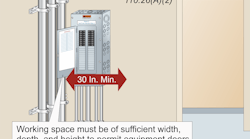For the safe operation and maintenance of equipment, access to and egress from working space must exist around all electrical equipment [Sec. 110.26]. Spaces around electrical equipment (width, depth, and height) consist of working space for worker protection [Sec. 110.26(A)] and dedicated space to provide access to, and protection of, equipment [Sec. 110.26(E)].
Equipment that may need examination, adjustment, servicing, or maintenance while energized must have working space provided per Sec. 110.26(A)(1), (2), (3), and (4). NFPA 70E, Standard for Electrical Safety in the Workplace, guides us in determining the severity of potential exposure, planning safe work practices including establishing an electrically safe work condition, arc flash labeling, and selecting personal protective equipment.
The depth of working space, which you measure from the enclosure front (not the live parts), cannot be less than the distances in Table 110.26(A)(1). These distances are determined by voltage-to-ground and three different conditions:
- Condition 1. Exposed live parts on one side of the working space and no live or grounded parts (including concrete, brick, or tile walls) on the other side of the working space. Concrete, brick, tile, and similar surfaces are considered grounded.
- Condition 2. Exposed live parts on one side of the working space and grounded parts on the other.
- Condition 3. Exposed live parts on both sides of the working space.
If the working space is a platform, size it to the working space requirements.
Working space is not required at the back or sides of equipment where all connections and all renewable, adjustable, or serviceable parts are accessible from the front (dead-front equipment) [Sec. 110.26(A)(1)(a)]. Sections of equipment that require rear or side access to make field connections must be marked by the manufacturer on the front of the equipment [see Sec. 408.18(C)].
If electrical equipment is being replaced, Condition 2 working space is permitted between dead-front switchboards, switchgear, panelboards, or motor control centers located across the aisle from each other. But only where conditions of maintenance and supervision ensure that written procedures have been adopted to prohibit equipment on each side of the aisle from being open at the same time, and only authorized, qualified persons will service the installation [Sec. 110.26(A)(1)(c)].
The width of the working space must be at least 30 in., but in no case less than the width of the equipment [Sec. 110.26(A)(2)]. The width of the working space can be measured from left to right, from right to left, or simply centered on the equipment. It can overlap the working space for other electrical equipment.
The working space must be of sufficient width, depth, and height to permit equipment doors to open at least 90 degrees (Fig. 1).
The height of the working space must be clear and extend from the grade, floor, or platform to a height of 6½ ft or the height of the equipment, whichever is greater [Sec. 110. 26(A)(3)]. Other equipment, such as raceways, cables, wireways, transformers, or support structures (such as concrete pads) can extend no more than 6 in. beyond the front of the electrical equipment.
Exception No. 2: The minimum height of working space does not apply to a service disconnect or panelboards rated 200A or less located in an existing dwelling unit.
Exception No. 3: Meters can be installed in the required working space. Where equipment likely to require examination, adjustment, servicing, or maintenance while energized is above a suspended ceiling or crawl space, all the following conditions apply [110.26(A)(4)]:
(1) Equipment installed above a suspended ceiling must have an access opening at least 22 in. × 22 in., and equipment installed in a crawl space must have an accessible opening at least 22 in. × 30 in.
(2) The width of the working space must be at least 30 in., but in no case less than the width of the equipment.
(3) The working space must permit equipment doors to open 90 degrees.
(4) The working space in front of the equipment must comply with the depth requirements of Table 110.26(A)(1). Horizontal ceiling structural members are permitted in this space.
Clear working space
The working space must always be clear; therefore, this space can’t be used for storage [Sec. 110.26(B)] (Fig. 2).
It is inherently dangerous to service energized parts. It is unacceptable to be subjected to additional dangers by working around bicycles, boxes, crates, appliances, and other impediments. Don’t work in such an area until these items are removed.
When working in a passageway and live parts are exposed for inspection or servicing, the working space should be guarded against use by occupants. When working on electrical equipment in a passageway, be mindful of the potential for a fire alarm. If one occurs, you may need to secure equipment covers and clear the passageway of ladders, tools, and other items that impede egress by the occupants.
You must install signaling and communications equipment in a manner that does not encroach on the working space of the electrical equipment.
At least one entrance large enough to give access to (and egress from) the working space must exist [Sec. 110.26(C)(1)]. Find out what the authority having jurisdiction considers “large enough” based on the conditions of use. Building codes contain minimum dimensions for doors and openings for personnel travel, but certain assumptions are made, and those might not apply to your application.
For large equipment containing overcurrent, switching, or control devices, an entrance to (and egress from) the required working space at least 24 in. wide and 6½ ft high is required at each end of the working space [Sec. 110.26(C)(2)]. This requirement applies to either of the following conditions:
(1) Any of the equipment is over 6 ft wide and rated at least 1,200A.
(2) The service disconnecting means installed per Sec. 230.71(B) has a combined rating of 1,200A or more and is over 6 ft wide.
Open equipment doors must not impede entry to or egress from the working space. A single entrance for access to and egress from the required working space is permitted if the egress is unobstructed or if the working space depth is doubled. What does “doubled” mean? The edge of the entrance is no closer than the required working space distance required by Sec. 110.26(A)(1).
This next requirement applies where the equipment is rated 800A or more and includes overcurrent, switching, or control devices. If a personnel door is less than 25 ft from the nearest edge of the working space, the door must open in the direction of egress and be equipped with listed panic or listed fire exit hardware [Sec. 110.26(C)(3)] (Fig. 3).
A poorly lit work area means people will be forced to use up some of their working space with portable lights. So for that and other reasons, illumination is required for all working spaces about service equipment, switchboards, switchgear, panelboards, or motor control centers installed indoors [Sec. 110.26(D)]. At least some of the illumination within the working space must not be controlled by automatic means.
Additional lighting outlets are not required where the working space is illuminated by an adjacent light source, or as permitted by Sec. 210.70(A)(1) Exception No. 1 for switched receptacles. This, however, doesn’t mean you can’t provide additional lighting if doing so would likely make people safer. Use good judgment.
Service equipment, switchboards, and panelboards must have dedicated equipment space and be protected from damage that could result from condensation, leaks, breaks in foreign systems, and vehicular traffic. Specific requirements exist for indoor applications [Sec. 110.26(E)(1)] and outdoor applications [Sec. 110.26(E)(2)].
For example:
- For indoor installations, the footprint space (width and depth of the equipment) extending from the floor to a height of 6 ft above the equipment or to the structural ceiling, whichever is lower, must be dedicated to electrical equipment. No piping, ducts, or other equipment foreign to the electrical system can be installed in this dedicated electrical equipment space.
- For outdoor installations, switchboards and panelboards must be installed in identified enclosures and protected from accidental contact by unauthorized personnel or by vehicular traffic. The working clearance space includes the zone described in Sec. 110.26(A). Architectural appurtenances or other equipment are not permitted within this zone.
Rooms or enclosures containing electrical equipment controlled by a lock are considered accessible to qualified persons [Sec. 110.26(F)].
The right distance
Remember, the NEC and OSHA give the minimum working space distances for various types of conditions. Those are not the average, maximum, or target distances. The NEC specifically uses the language “…to permit ready and safe operation and maintenance….” [Sec. 110.26].
The distance in your particular application might conform with Table 110.26(A)(1) and still fall short of the “ready and safe” standard. And though this aspect is not covered by the NEC [Sec. 90.1], good engineering requires consideration of what additional distance would improve efficiency for operation or maintenance.
These materials are provided by Mike Holt Enterprises in Leesburg, Fla. To view Code training materials offered by this company, visit www.mikeholt.com/code.








